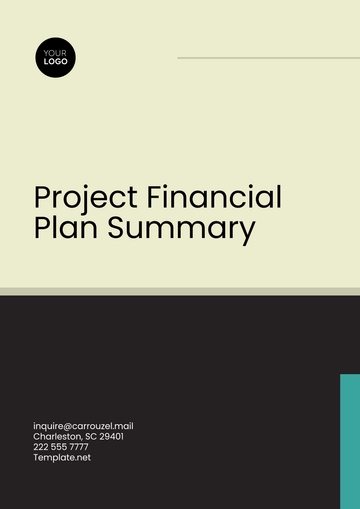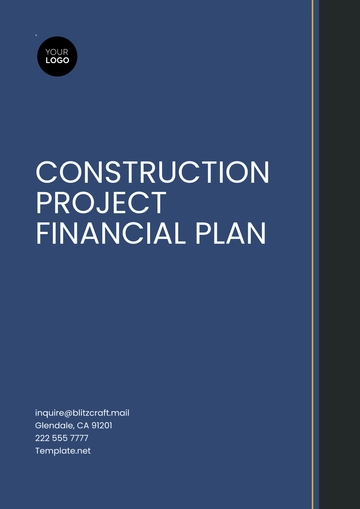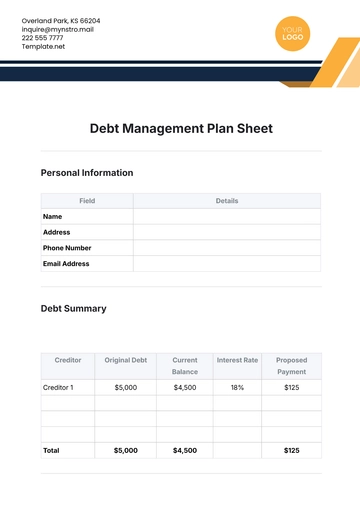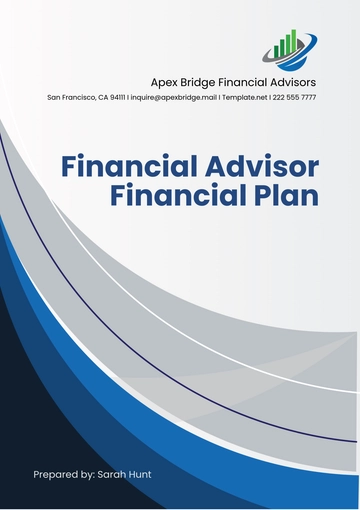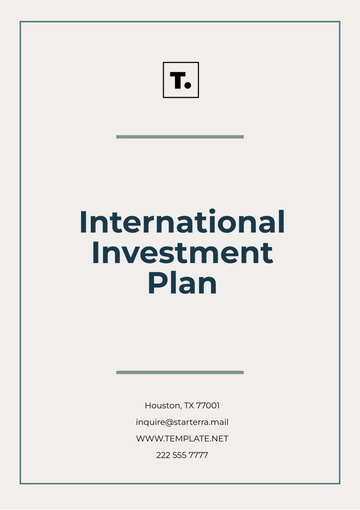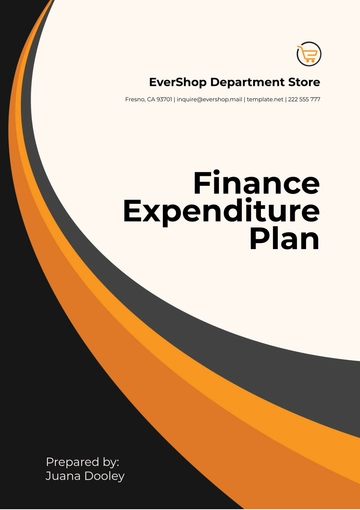Free Long-Term Financial Cost Plan
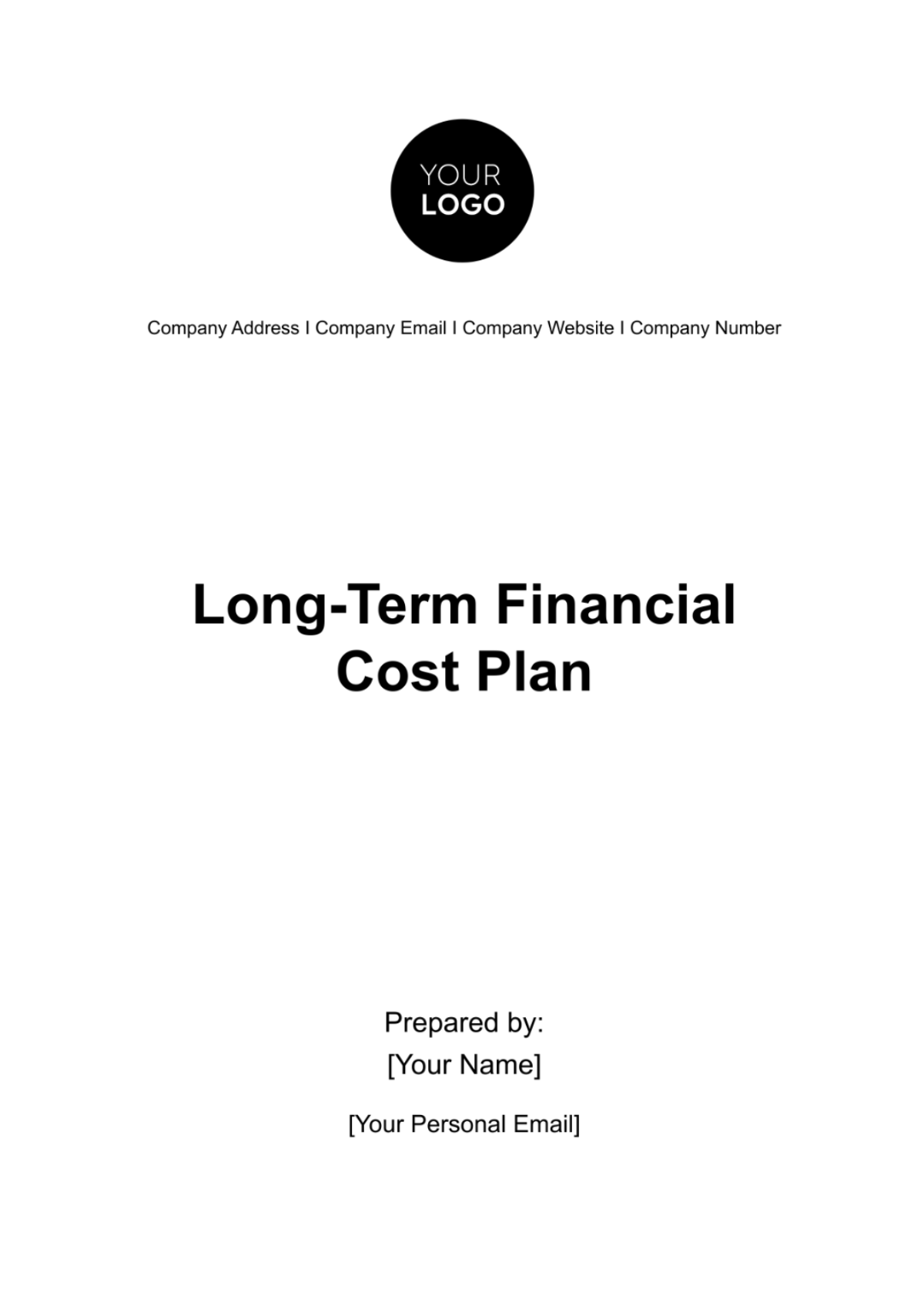
I. Executive Summary
This plan lays the groundwork for sustained financial stability and growth over an extended period. The plan emphasizes adaptability to economic factors such as inflation and interest rates, ensuring resilience in the face of evolving market conditions. By focusing on revenue growth optimization, cost management strategies, and strategic capital expenditure allocation, the organization aims to enhance operational efficiency and capitalize on emerging opportunities. With a commitment to strategic financial planning, the organization is poised for long-term success, guided by the recommendations and assumptions outlined in this comprehensive document.
II. Organizational Overview
A. Mission Statement
Guided by our mission, we commit to enhancing lives through innovative solutions, sustainable practices, and unparalleled customer value.
B. Vision Statement
Our vision is to stand as a global pioneer, recognized for excellence, environmental stewardship, and positive societal impact across our industry.
C. Strategic Goals
Market Expansion
We set a strategic target to expand our market presence by 15%, capitalizing on synergistic partnerships and strategic geographic expansions.
Innovation Leadership
Our commitment to innovation is exemplified by the imminent launch of three groundbreaking products in the upcoming fiscal year, solidifying our position as an industry leader.
Sustainability Excellence
Determined to reduce our carbon footprint by 20%, we are implementing sustainability practices across our operations and supply chain, aligning our growth with environmental responsibility.
III. Market and Economic Analysis
A. Industry Overview
Our industry anticipates sustained growth, projecting a Compound Annual Growth Rate (CAGR) of 8% over the next decade. We navigate this dynamic landscape with an unwavering commitment to innovation and consumer satisfaction.
B. Economic Conditions
Current economic conditions are characterized by low-interest rates and moderate inflation, influencing our strategic financial planning. We remain vigilant against potential geopolitical events that may introduce uncertainties impacting consumer confidence and spending patterns.
C. Regulatory Landscape
Proactively navigating the regulatory landscape, we anticipate changes in environmental standards. Our commitment involves aligning manufacturing processes and sourcing strategies with evolving standards, ensuring seamless compliance and market access.
D. Technological Landscape
Embracing advancements in automation and artificial intelligence, we aim to optimize costs in manufacturing processes. Strategic investments in research and development are poised to leverage emerging technologies, enhancing our operational efficiency.
E. Consumer Trends
We align with evolving consumer preferences, recognizing the growing demand for sustainable and ethically sourced products. Our strategic focus on eco-friendly practices not only aligns with market demands but also fosters brand loyalty and consumer trust.
F. SWOT Analysis
Strengths
Our established brand reputation fuels unwavering customer loyalty.
Our robust supply chain management ensures operational efficiency even in complex market conditions.
Weaknesses
Mitigating dependency on a few key suppliers remains a strategic priority.
Expanding our presence in emerging markets is recognized as a growth opportunity.
Opportunities
Exploring untapped markets offers significant potential for expansion.
The increasing demand for eco-friendly products aligns seamlessly with our sustainability focus.
Threats
Fierce competition challenges our market share, necessitating continuous innovation.
Navigating regulatory uncertainties remains a key aspect of our risk management strategy.
IV. Expense Projections
Effective financial planning relies on accurate expense projections. The table below outlines forecasts for our expenses:
Category | [2050] | [2051] | [2052] |
[Personnel Expenses] | [$2,500,000] | [$2,800,000] | [$3,100,000] |
The projections show a balanced approach, with expenses increasing gradually across various categories. The overall trend reflects a strategic consideration of potential adjustments, expansions, and market dynamics, ensuring a comprehensive outlook that supports organizational objectives and growth strategies. The conservative approach in projecting expenses provides flexibility to accommodate unforeseen circumstances, contributing to a robust financial plan that aligns resources with the organization's long-term vision and objectives.
V. Capital Expenditure Plan
Strategic growth demands a thoughtful plan. The table below outlines our long-term investments in various projects over the next three years:
Project | [2050] | [2051] | [2052] |
[Technology Upgrade] | [$3,200,000] | [$3,500,000] | [$3,800,000] |
This plan reflects a strategic allocation of resources, focusing on projects that contribute to our overall growth and competitiveness. Each project's budget is carefully structured to accommodate potential variations in costs, ensuring financial prudence and effective utilization of resources. This serves as a guiding framework for the realization of initiatives that align with our organizational goals and long-term vision.
VI. Debt Service Plan
Maintaining financial stability involves a meticulous plan. The table below outlines our repayment plan for long-term loans associated with specific projects:
Loan | [2050] | [2051] | [2052] |
[Expansion Loan] | [$1,500,000] | [$1,200,000] | [$1,000,000] |
This plan is crafted to ensure timely repayment, managing our financial liabilities efficiently. The allocations for each loan showcase a balanced approach, considering our cash flow projections and financial stability. This strategic debt management approach allows us to fulfill our financial obligations while safeguarding our overall fiscal health.
VII. Financial Assumptions
The table below provides a detailed breakdown of financial assumptions, enabling stakeholders to understand the underlying financial parameters:
Category | [2050] | [2051] | [2052] |
[Revenue Growth] | [5%] | [6%] | [8.5%] |
An assumed moderate growth of revenue reflects the organization's strategic trajectory. This is assumed to gradually increase during the period of three years. In essence, these assumptions collectively serve as guiding pillars, fostering adaptability and informed decision-making within the dynamic landscape which ensures transparency.
VIII. Inflation and Economic Factors
A. Inflation Factors
Raw Materials Pricing
The organization may face the challenge of increased production costs, as inflation-driven spikes in raw material prices could exert pressure on the overall cost structure, necessitating strategic considerations in procurement and resource allocation.
Labor Costs
Elevated labor costs, stemming from wage increases and evolving workforce dynamics influenced by inflation, could impact operational budgets, prompting a need for comprehensive workforce management strategies to optimize efficiency and mitigate potential financial strains.
Energy and Utilities
The organization may experience heightened operational expenses due to inflation-driven rises in energy prices and utility costs, necessitating a strategic approach to energy efficiency and cost-effective utility management.
B. Economic Factors
Interest Rates
Elevated borrowing costs resulting from fluctuating interest rates pose a potential challenge to the organization's financial stability, requiring prudent financial planning and exploration of refinancing options to manage debt obligations effectively.
Transportation Costs
Potential increases in transportation costs, influenced by economic conditions and fuel price fluctuations, may impact supply chain logistics and distribution, urging the organization to explore optimization strategies and negotiate favorable transportation contracts.
Regulatory Compliance
Changes in regulatory requirements may introduce shifts in compliance costs, emphasizing the importance of staying vigilant to regulatory developments and adapting business practices to ensure compliance in a cost-effective manner.
IX. Scenario Analysis
A. Economic Downturn
In the scenario of an economic downturn, the organization anticipates a decrease in consumer spending, prompting a strategic focus on cost-effective marketing strategies and targeted promotions. Additionally, streamlined production processes and renegotiated supplier contracts may be explored to identify potential cost reductions.
B. Market Expansion
The analysis of market expansion scenarios highlights increased investment in marketing, distribution, and talent acquisition. Simultaneously, the organization may benefit from economies of scale in production, resulting in a projected reduction in unit costs as market share expands.
C. Supply Chain Disruptions
In scenarios involving supply chain disruptions, the organization emphasizes the development of contingency plans and alternative sourcing strategies. Strategic partnerships become crucial to enhance supply chain resilience, minimizing potential cost fluctuations.
D. Technological Advances
The impact of technological advances is analyzed in terms of upfront costs associated with adoption and forecasted long-term operational efficiency gains. Cost savings through automation and digitalization are explored, aligning technology adoption with budgetary constraints.
E. Competitor Actions
Monitoring potential cost impacts resulting from various competitive scenarios is paramount. The organization anticipates the need for strategic differentiation and innovation to maintain competitiveness without compromising cost-effectiveness.
F. Global Events
The analysis of global events scenarios involves preparing for potential supply chain disruptions and geopolitical changes. The organization establishes risk mitigation strategies to navigate uncertainties, minimizing the impact of external factors on operational costs.
G. Continuous Improvement Strategies
The continuous improvement aspect underscores the importance of ongoing refinement in operational processes, cost management, and resource allocation. Through regular reviews and adaptations, the organization aims to ensure sustained competitiveness and financial stability.
X. Recommendations
A. Revenue Growth Optimization
Leverage data-driven marketing strategies to capitalize on identified growth opportunities and maximize revenue potential.
Explore diversification strategies in product/service offerings to tap into emerging markets and customer segments.
B. Cost Management Strategies
Implement proactive cost control measures to mitigate the impact of potential increases in the cost of goods sold (COGS).
Continuously assess operating expenses, identifying areas for efficiency improvement and optimizing resource allocation.
C. Strategic Capital Expenditure Allocation
Align capital expenditure plans with the organization's long-term growth objectives, ensuring investments contribute directly to value creation.
Prioritize technology investments that enhance operational efficiency and support future scalability.
D. Debt Servicing and Financial Stability
Monitor interest rate trends closely and consider refinancing options to optimize debt structures and reduce interest expenses.
Establish a robust risk management framework to mitigate potential financial risks associated with changes in interest rates.
E. Inflation-Resilient Financial Planning
Factor in inflation impacts when setting prices and budgeting, ensuring that revenue and expenditure projections remain resilient to economic changes.
Evaluate supplier contracts and negotiate favorable terms to navigate potential cost increases associated with inflation.
XI. Conclusion
In conclusion, this plan serves as a comprehensive roadmap for the organization's financial trajectory, encompassing revenue growth, cost management, strategic investments, and risk mitigation. The outlined assumptions and corresponding recommendations provide a robust framework for informed decision-making and adaptive financial planning. Through a proactive approach to market dynamics, the organization can capitalize on opportunities, navigate potential challenges, and ensure financial resilience. This plan emphasizes the importance of aligning financial strategies with long-term organizational goals, fostering adaptability, and maintaining a vigilant stance in a dynamic economic landscape. By adhering to the outlined recommendations and continually monitoring and adjusting financial strategies, the organization can position itself for sustained success and resilience over the envisaged long-term horizon.
- 100% Customizable, free editor
- Access 1 Million+ Templates, photo’s & graphics
- Download or share as a template
- Click and replace photos, graphics, text, backgrounds
- Resize, crop, AI write & more
- Access advanced editor
Chart your long-term financial course effortlessly with the Long-Term Financial Cost Plan Template from Template.net! Tailor it dynamically for strategic long-term planning, ensuring financial stability. Customize it for sustained cost management and financial success. Leverage the advanced functionalities of the AI Editor Tool within this editable and customizable template today!
You may also like
- Finance Plan
- Construction Plan
- Sales Plan
- Development Plan
- Career Plan
- Budget Plan
- HR Plan
- Education Plan
- Transition Plan
- Work Plan
- Training Plan
- Communication Plan
- Operation Plan
- Health And Safety Plan
- Strategy Plan
- Professional Development Plan
- Advertising Plan
- Risk Management Plan
- Restaurant Plan
- School Plan
- Nursing Home Patient Care Plan
- Nursing Care Plan
- Plan Event
- Startup Plan
- Social Media Plan
- Staffing Plan
- Annual Plan
- Content Plan
- Payment Plan
- Implementation Plan
- Hotel Plan
- Workout Plan
- Accounting Plan
- Campaign Plan
- Essay Plan
- 30 60 90 Day Plan
- Research Plan
- Recruitment Plan
- 90 Day Plan
- Quarterly Plan
- Emergency Plan
- 5 Year Plan
- Gym Plan
- Personal Plan
- IT and Software Plan
- Treatment Plan
- Real Estate Plan
- Law Firm Plan
- Healthcare Plan
- Improvement Plan
- Media Plan
- 5 Year Business Plan
- Learning Plan
- Marketing Campaign Plan
- Travel Agency Plan
- Cleaning Services Plan
- Interior Design Plan
- Performance Plan
- PR Plan
- Birth Plan
- Life Plan
- SEO Plan
- Disaster Recovery Plan
- Continuity Plan
- Launch Plan
- Legal Plan
- Behavior Plan
- Performance Improvement Plan
- Salon Plan
- Security Plan
- Security Management Plan
- Employee Development Plan
- Quality Plan
- Service Improvement Plan
- Growth Plan
- Incident Response Plan
- Basketball Plan
- Emergency Action Plan
- Product Launch Plan
- Spa Plan
- Employee Training Plan
- Data Analysis Plan
- Employee Action Plan
- Territory Plan
- Audit Plan
- Classroom Plan
- Activity Plan
- Parenting Plan
- Care Plan
- Project Execution Plan
- Exercise Plan
- Internship Plan
- Software Development Plan
- Continuous Improvement Plan
- Leave Plan
- 90 Day Sales Plan
- Advertising Agency Plan
- Employee Transition Plan
- Smart Action Plan
- Workplace Safety Plan
- Behavior Change Plan
- Contingency Plan
- Continuity of Operations Plan
- Health Plan
- Quality Control Plan
- Self Plan
- Sports Development Plan
- Change Management Plan
- Ecommerce Plan
- Personal Financial Plan
- Process Improvement Plan
- 30-60-90 Day Sales Plan
- Crisis Management Plan
- Engagement Plan
- Execution Plan
- Pandemic Plan
- Quality Assurance Plan
- Service Continuity Plan
- Agile Project Plan
- Fundraising Plan
- Job Transition Plan
- Asset Maintenance Plan
- Maintenance Plan
- Software Test Plan
- Staff Training and Development Plan
- 3 Year Plan
- Brand Activation Plan
- Release Plan
- Resource Plan
- Risk Mitigation Plan
- Teacher Plan
- 30 60 90 Day Plan for New Manager
- Food Safety Plan
- Food Truck Plan
- Hiring Plan
- Quality Management Plan
- Wellness Plan
- Behavior Intervention Plan
- Bonus Plan
- Investment Plan
- Maternity Leave Plan
- Pandemic Response Plan
- Succession Planning
- Coaching Plan
- Configuration Management Plan
- Remote Work Plan
- Self Care Plan
- Teaching Plan
- 100-Day Plan
- HACCP Plan
- Student Plan
- Sustainability Plan
- 30 60 90 Day Plan for Interview
- Access Plan
- Site Specific Safety Plan

